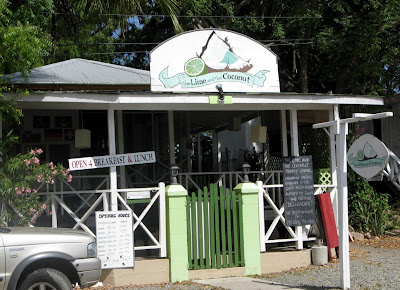Although we anchored at Bourg des Saintes overnight, we found it rough in the anchorage with marginal holding, so we decided to leave without going ashore and try our luck with Deshaies on Guadeloupe proper. We had a great sail across the passage, punctuated by a downpour, and were doing 7 knots easily with only the jib. It was really fun.
The fast sailing continued most of the way along the leeward side of Guadeloupe, much to my surprise. I thought the mountains would block all the wind, but instead they seemed to channel it. We did finally hit a wind shadow and were forced to turn on the engine for awhile, but the wind came back soon. And when it returned, there was even more of it. At one point we reached 9 knots speed over ground. We assume there was favorable current, as well, because that's faster than our maximum hull speed. When the wind started gusting over 30 knots, we decided it was time to bring the sail in (although John was having fun and would have left it longer). So we fell off in order to furl the sail.
That's when the not-fun part started. In windy conditions John goes forward to pull the retrieval line because it's easier. But even then, he was having trouble getting it started, so he told me to ease the sheet more. That made it flap around, and it knocked his glasses off despite the keeper on them. Things were happening very quickly and noisily at this point. I could see a gap at the foot of the sail, and then John yelled that the halyard had broken. At that point, the thing to do was to drop the sail, but the bolt line jammed at the bottom of the feed, and John couldn't free it. We furled it as well as possible, which wasn't very well, and raised the staysail to help us against the wind.
We were trying for the anchorage at Deshaies, Guadeloupe, but the entrance was straight into the wind, and we simply couldn't make it in there. So we decided to head for Antigua even though it meant entering and anchoring in the dark. I picked Falmouth Harbour over English Harbour because it looked like a simpler entry and is larger, so it would likely be less crowded. Night entry isn't recommended for either bay because navigation lights are often out, but with GPS and chart plotter, we don't have to depend on the lights. The choice was a good one, and we anchored fairly easily about 10:30 p.m. just past the reef at the entrance to the bay. John took the furler feed apart, so we were finally able to bring the jib down before we went to bed.
In the morning we discovered that we had anchored next to Robert on Silver Harmony, a young Scot whom we met briefly at La Palma in the Canaries. He told us where we could tie the dinghy ashore, and in the evening we had him over for sun-downers to get caught up on stories.

We've found an optician and a sail maker. New glasses are being made, and the sail is being repaired. The sail maker, Franklyn at A & F Sails, also gave us the name of a rigger. We'll need professional help replacing the jib halyard. The rigger will come to the boat on Monday.
Our friend Chris on Avocette is in English Harbour, as is most of the cruising community, we're told. We haven't actually seen him yet, but we'll be meeting him this evening for our introduction to the Tot Club. We'll probably stay in Falmouth Harbour ourselves. The water out here where we are is nice, and we can easily walk to English Harbour from the dinghy dock at the Antigua Yacht Club.

No comments:
Post a Comment